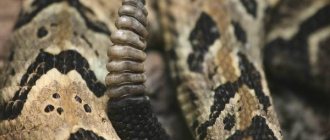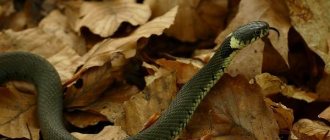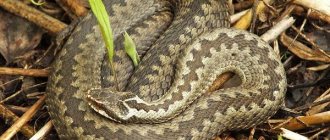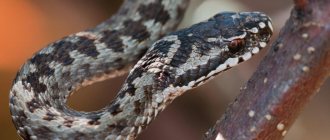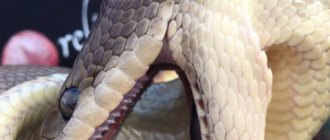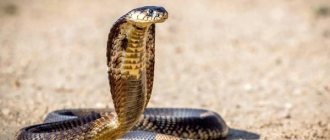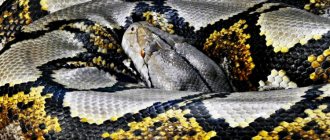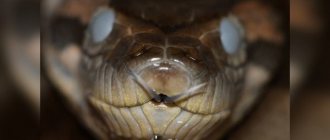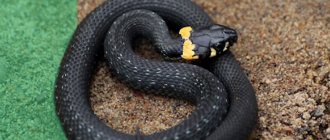- Wild animals
- >>
- Reptiles
Surely, many have heard about such a reptile as a rattlesnake , so named because of the terrifying rattle that crowns the tip of its tail. Not everyone knows that the poisonousness of this snake family is simply off the charts; there are many deaths from rattlesnake bites. But what is the character, lifestyle and habits of this poisonous person? Maybe, having learned about this in more detail, this reptile will no longer seem so scary and insidious?
Origin of the species and description
Photo: Rattlesnake
Rattlesnakes are poisonous creatures belonging to the viper family. They are classified as a subfamily of pit snakes due to the fact that in the area located between the nostrils and eyes of reptiles there are pits that are hypersensitive to temperature conditions and infrared radiation. These devices help to sense the presence of prey precisely by its body temperature, which differs from the temperature of the surrounding air. Even in pitch darkness, a rattlesnake will sense the slightest change in temperature and detect potential prey.
Video: Rattlesnake
So, one of the main characteristics of rattlesnakes or rattlesnakes, or pitheads, is the above-described pit receptors. Then the question arises: “Why is the snake called a rattlesnake?” The fact is that some varieties of this creeping creature have a rattle at the end of the tail, consisting of movable scales, which, when shaken by the tail, produce a sound reminiscent of crackling.
Interesting fact: Not all rattlesnakes have a tail rattle, but those who do not have one are still classified as rattlesnakes (pit rattlesnakes).
There are two genera of reptiles that can undoubtedly be classified as rattlesnakes: true rattlesnakes (Crotalus) and pygmy rattlesnakes (Sistrurus).
Their closest relatives include:
- Cottonmouths;
- spear-headed snakes;
- temple keffiyehs;
- bushmasters.
In general, the subfamily of pitheads has 21 genera and 224 snake species. The genus of true rattlers consists of 36 species.
Let's describe some of them:
- The Texas rattlesnake is very large, its length reaches two and a half meters, and its weight is about seven kilograms. It inhabits the USA, Mexico and southern Canada;
- the monstrous rattlesnake, also of considerable size, reaching a length of two meters, is registered in the west of Mexican territory;
- the diamondback rattlesnake is very beautifully colored with contrasting diamonds, and its dimensions are impressive - up to 2.4 m. The snake inhabits Florida (USA) and is fertile, producing up to 28 offspring;
- The horned rattlesnake is distinguished by skin folds located above the eyes, which are similar to horns; they prevent sand from getting into the snake's eyes. This reptile is not large in size; its body length ranges from 50 to 80 cm;
- The striped rattlesnake lives in the southern part of the United States, it is very dangerous, its concentrated venom can be fatal to the one bitten;
- the rock rattlesnake, less than a meter long (about 80 cm), lives in the southern part of the States and in Mexican territory. Its venom is very potent, but its character is not aggressive, so there are not many victims of bites.
The genus of dwarf rattlers includes only a couple of species:
- The millet pygmy rattlesnake inhabits the southeast of the North American continent, its length is about 60 cm;
- the chain rattlesnake (massasauga) has chosen Mexico, the USA and the southern part of Canada. The length of the snake’s body is no more than 80 cm.
Appearance and features
Photo: Gremuchnik
Snakes of the pit family have different sizes; depending on a particular variety, the length of their body can be from half a meter to more than three meters.
The coloring also has different variations and tones; rattlers can be:
- beige;
- bright green;
- emerald;
- white;
- silver;
- black;
- brownish-red;
- yellowish;
- dark brown.
Uniformity in color is present, but is much less common; specimens with various patterns predominate: diamond-shaped, striped, spotted. Some species generally have original patterns of various intricacies.
Of course, rattlers also have common features that are not related to one or another species or place of residence of the reptile. This is a wedge-shaped head, a pair of long poisonous fangs, sensitive locator pits and a rattle or rattle with which the tail is equipped (do not forget that some species do not have it). The rattle is presented in the form of a growth of dead skin scales; with each moult, their number increases, but the age of the snake cannot be determined from them, because the outermost scales of the rattle gradually completely fly off the tail.
The reptile uses the rattle for warning purposes; it scares large animals and humans with it, thereby saying that it is better to avoid it, as rattlers show a kind of humanity.
The secret of the rattle
The rattlesnake, as already mentioned, has a rattle at the end of its tail. For some time it was not clear why a snake, hunting in the dark and not making a single sound, was suddenly endowed with such an unmasking agent by nature. But everything falls into place if you know who exactly she is hunting. Its diet consists of small mammals and birds. She warns large animals (including humans) by making noise with her rattle. Thus, it can be considered the most humane of the venomous snakes.
This growth at the end of the tail consists of dead scales. Their number increases with each change of the reptile's skin. Therefore, by counting the scales on a rattle, you can find out how long the snake has lived. The inside of the rattle is completely empty, which is why the sound is so loud.
Where does the rattlesnake live?
Photo: Poisonous rattlesnake
Judging by the research of herpetologists, one second of all rattlesnakes have chosen the American continent (approximately 106 species). 69 species have settled in southeast Asia. Only copperheads inhabit both hemispheres of the Earth. There are two species of copperheads living in our country - the common and the oriental; they are registered in the Far East and also live in Azerbaijan and Central Asia. The eastern one can be found in the vast expanses of China, Korea and Japan, where the local population actively uses it for food.
The common copperhead has also become a favorite in Afghanistan, Korea, Mongolia, Iran, and China; the humpbacked copperhead can be found in Sri Lanka and India. Gladky occupies Indochina, Java and Sumatra. It is not difficult to guess that the Himalayan copperhead lives in mountain ranges, climbing to a height of five kilometers.
All kinds of keffiyehs are deployed in the countries of the Eastern Hemisphere, the largest of which is the one and a half meter khaba inhabiting Japan. Mountain keffiyehs live on the Indochina Peninsula and in the Himalayan mountain ranges, and bamboo ones live in the territories of Pakistan, India and Nepal.
So, humid jungles, high mountain ranges, and arid deserts are not alien to pitheads. There are also aquatic varieties of these snakes. Rattlers live in the crowns of trees, on the ground, and high in the mountains. During the day, when the heat prevails, they do not leave their shelters, located under boulders, in rocky crevices, and in the burrows of various rodents. In search of the most favorable and secluded place to rest, reptiles use the same sensitive locator pits that do not let them down.
Competition “Bio/Mol/Text”-2021/2022
This work was published in the “Free Topic” category of the “Bio/Mol/Text” competition - 2021/2022.
The nomination partner is SkyGen: a leading distributor of life science products on the Russian market.
The general partner of the competition is the international innovative biotechnology company BIOCAD.
The general partner of the competition is: the largest supplier of equipment, reagents and consumables for biological research and production.
"Book" sponsor of the competition - "Alpina Non-Fiction"
What does a rattlesnake eat?
Photo: Rattlesnake from the Red Book
The menu of pitheads is quite varied, it consists of:
- mice;
- hares;
- rats;
- birds;
- lizards;
- frogs;
- all kinds of insects;
- other small snakes.
The young feed on insects and attract lizards and frogs with their bright tip of the tail. Rattlers have a lot of patience; they can wait a long time for a potential victim, hiding in ambush. As soon as it approaches the required distance, which is suitable for throwing, the snake’s neck bends and attacks the poor thing with lightning speed. The length of the throw reaches a third of the reptile's body length.
Like all viper relatives, pit vipers do not use any suffocating techniques on the victim, but kill it with their poisonous bite. As already mentioned, in impenetrable darkness, their thermal trapping pits help them detect prey, which sense even the slightest change in temperature instantly, thanks to which rattlers see the infrared silhouette of the prey. After the poisonous blow has been successfully completed, the snake begins its meal, always swallowing the lifeless body from the head.
In one sitting, a rattlesnake can eat a considerable amount of food, which is half the mass of the hunter herself. This is not surprising, because rattlers eat approximately once a week, so they go out hunting when they are pretty hungry. It takes a lot of time to digest, which is why the breaks between meals are so long. Reptiles also need water; they get some of the moisture from the food they catch, but they don’t have enough of it. Snakes drink in a unique way: they immerse their lower jaw in water, thus feeding the body with the necessary liquid through the capillaries of the mouth.
Interesting fact: Rattlers in captivity often go on a hunger strike; they are not even bothered by rodents running past. There are cases where reptiles have not eaten for more than one year.
Features of character and lifestyle
Photo: Pit rattlesnake
The diversity of rattlers is so great that their permanent locations are completely different territories. Some species practice a terrestrial existence, others are arboreal, others are aquatic, and many occupy mountain ranges. Still, they can be called heat-loving; the average optimal temperature for them is from 26 to 32 degrees plus. They can also survive a short cold snap of up to 15 degrees.
With the arrival of cold weather, snakes hibernate, all their life processes slow down very much. Many species of rattlesnake form large aggregations (up to 1000 pieces) to make it easier to survive hibernation. When they all come out of suspended animation at the same time, you can observe a kind of snake invasion, this is a terrifying sight. Some species overwinter alone.
Snakes, especially those in position, love to bask in the rays of the first sun. In unbearable heat, they prefer to hide in secluded shady places: under stones, in holes, under dead wood. In such hot weather, they begin to be active at dusk, getting out of their shelter.
Interesting fact: Many species of rattlesnake settle in the same den for generations, passing it on by inheritance for many years. Often entire colonies of snakes live in such ancestral possessions.
These reptiles do not have an aggressive disposition; they will not attack a person or large animal without a reason. With their rattle they give a warning that they are armed and dangerous, but an attack will not follow unless they are provoked. When there is nowhere to go, the rattlesnake makes its poisonous attack, which can lead to the death of the enemy. In the United States alone, 10 to 15 people die from rattlesnake bites every year. In regions where snakes are common, many people carry an antidote with them, otherwise there would be many more victims. So, the rattlesnake attacks only in extreme situations, for the purpose of self-defense, having a timid and peaceful disposition.
It should be noted that the rattlesnake's vision is not its strongest point; it sees objects blurry if they are not in motion and reacts only to moving objects. Its main and very sensitive organs are the sensory pits, which react even to minute changes in temperature near the reptile.
Social structure and reproduction
Photo: Rattlesnake
For the most part, rattlers are viviparous, but there are some species that are oviparous. A sexually mature male snake is ready for annual mating games, and the female takes part in them once every three years. The wedding season can be in spring or early autumn, it depends on the species and habitat of the snake.
When a lady is ready to be courted by gentlemen, she releases specific-smelling pheromones that attract potential partners. The male begins to pursue his passion, sometimes they crawl and rub their bodies against each other for several days. It happens that more than one gentleman claims the heart of a woman, so duels take place between them, where the chosen one is the winner.
Interesting fact: A female can store a male’s sperm until the next wedding season, i.e. she can have offspring without the participation of a male.
Ovoviviparous snakes do not lay eggs; they develop in utero. Usually between 6 and 14 babies are born. Oviparous rattlers in a brood can have from 2 to 86 eggs (usually 9 - 12 pieces), which they tirelessly protect from any attacks.
At approximately ten days of age, the babies undergo their first molt, as a result of which a rattle begins to form. The tails of young animals are often very brightly colored, standing out sharply against the background of the entire body. Snakes, moving these bright tips, lure lizards and frogs to them for a snack. On average, the life of rattlesnakes in natural conditions lasts from 10 to 12 years, there are specimens that live up to twenty. In captivity, rattlers can live up to thirty years.
Lifestyle
In cold weather, the Texas rattlesnake becomes active only during the day, warming itself in the rays of the sun. In summer, when daytime temperatures rise very high, the rattlesnake is nocturnal, resting part of the day in an underground burrow located among the rocks.
Rattlesnakes perform special dances that were once considered part of a mating ritual. Now it has become known that this is how they demonstrate their strength - they compete without causing injury. In winter, 30 or more rattlesnakes gather in one underground burrow to spend the winter together, warming each other with body heat.
The general background of the body of the Texas rattlesnake is grayish-brown, with rhombic spots separated by white stripes. The tail is light, with black transverse lines.
Natural enemies of rattlesnakes
Photo: Rattlesnake
Although pitheads are poisonous and have a terrifying rattle on their tail, many ill-wishers themselves hunt them in order to feast on the reptiles.
Rattlers can become victims of:
- coyotes;
- foxes;
- raccoons;
- red-tailed hawks;
- large snakes;
- California running cuckoos;
- ferrets;
- martens;
- caresses;
- crow;
- peacocks
Most often, inexperienced young animals suffer and die from the attacks of the above enemies. Snake venom either has no effect on opponents of rattlers or has a very weak effect, so attacking animals and birds are not very afraid of it.
Interesting fact: A case was shown on television in which a fisherman caught a large trout, in whose stomach there was a swallowed rattlesnake more than half a meter long.
It is always sad to realize that humans have a detrimental effect on many fauna. Rattlesnakes are no exception to this list and are also often killed as a result of human intervention. People destroy reptiles, both directly, by hunting them in order to obtain beautiful snake skins, and indirectly, through their various activities that interfere with the normal life of rattlers.
In addition to all the enemies mentioned, snake individuals are greatly influenced by climatic conditions, which are sometimes very unfavorable and harsh. Especially young animals often do not survive cold times.
First aid instructions
Device for sucking snake venom
After being bitten, it is important to remain absolutely calm. This will help you clearly analyze the situation, avoid mistakes and protect yourself from repeated aggression by the animal.
Snakes themselves try to avoid contact with people and attack only in case of self-defense. Reptile attacks are always caused by a person who either deliberately provoked the rattlesnake or accidentally stumbled upon it.
Important. It is advisable to try to remember the snake, its pattern and characteristic features, and even better, take a photograph. The latter is quite simple nowadays since practically everyone has gadgets. Knowing the type of animal, it will be easier for doctors to choose a vaccine and treatment methods.
What do we have to do
- Move away from the rattlesnake to a safe distance. You need to be extra vigilant because there may be other snakes around.
- The victim should take a semi-recumbent position (the heart is higher than the level of the abdomen) and remain in a motionless, relaxed state. For a child, a limb can be secured with a splint; for the latter, it is better to use wide boards or sticks.
- If the bite was through clothing, it should be removed or torn, since some of the poison will likely be on the fabric.
- The victim should not be wearing rings, jewelry or tight clothing. All of the above must be removed, because the tissues will inevitably swell and it is important to avoid squeezing. Compression of the neck is especially dangerous.
- Try sucking out the venom with your mouth (for this you can use a special kit that is sold in reptile distribution areas). To do this, pinch the skin around the wound and massage, this will help enlarge the holes. Then start suctioning. This can be done provided that there are no open bleeding lesions in the mouth. Spit out the ichor. There is no need to cut the wound; this will only speed up the absorption of the poison. This measure must be applied immediately. Its duration is 15 minutes on average, because after more time the toxin penetrates deeply and it is not possible to remove it.
- Afterwards, rinse the wound with water. You can use soap or any colorless antiseptic. The goal is to sanitize damaged skin and prevent pathogenic microflora from entering it. Iodine or brilliant green will make it difficult to visualize when the doctor examines the wound.
- The bite site can be tightly covered with a cloth, but not tightly (not to be confused with applying a tourniquet) so that the index finger passes between the bandage and the bandage. This measure will somewhat slow down blood circulation, which is why the negative effect will not be so rapid.
- It is advisable to transport the injured person to the clinic by hand, cart or car, since he should not walk - physical activity will increase the poisoning.
- Take the patient to the nearest medical facility as soon as possible. As a rule, clinics in the USA, Canada and Mexico, where rattlers live, have an antidote. The situation is much worse when the bites are from reptiles kept in terrariums; for example, in Russia or Ukraine there are no antidotes against rattlesnakes.
Important. The bite site should be located below the level of the heart, however, the limb should not hang down, because the poison will concentrate in it, and this should absolutely not be allowed to prevent tissue necrosis.
What you can and cannot do if you are bitten by a rattlesnake
Actions that may cause harm
If you are bitten by a rattlesnake, you should not take the following measures:
- Apply a tourniquet above the wound. This will slow down the spread of the poison, but it will be concentrated in the limb, which can cause serious problems. Firstly, the toxin will begin to destroy tissue, cause necrosis and, as a result, the leg will need to be amputated; secondly, after removing the tourniquet, not only dangerous proteins introduced by the snake will enter the blood and lymph flow, but also decay products, which will significantly increase the poisoning of the body.
- Drinking alcohol or caffeine will in no way neutralize the poison.
- Cauterize the wound.
- There is absolutely no need to panic. This stimulates the adrenal glands to produce steroid hormones, which will increase blood circulation, increase blood pressure and heart rate. The more the affected person worries, the faster the toxic substances will spread throughout the body.
- Move. The more physical activity the bitten person exhibits, the more intensely the toxin is carried through the bloodstream.
- Catching a snake. There are recommendations to kill the animal or catch it (a more humane way) to verify it and determine the antidote. Such attempts are not advisable, as they can lead to new bites and even greater concentrations of poison in the body.
Population and species status
Photo: Dangerous rattlesnake
Unfortunately, the rattlesnake population is gradually declining. And the main reason for this situation is the human factor. People are invading the territories where these reptiles have always lived and displacing them, developing ever larger spaces. Deforestation, drainage of wetlands, large-scale plowing of land for agricultural needs, urban sprawl, construction of new highways, deterioration of the ecological situation, and depletion of the food supply lead to a reduction in rattlesnake insects. In some areas where they used to be common, they are now practically non-existent. All this suggests that the situation there is unfavorable for reptiles.
Humans harm rattlers not only through their barbaric actions, but also directly when they hunt snakes purposefully. The hunt is carried out in pursuit of beautiful snake skin, from which expensive shoes are made, bags and purses are sewn. In many countries (especially Asian ones), rattlesnake meat is eaten and many different dishes are prepared from it.
Surprisingly, common domestic pigs are immune to the venomous bites of rattlesnakes, apparently due to the fact that they are very thick-skinned. They happily feast on rattlers if they manage to catch them. For this purpose, farmers often release entire herds of pigs into the fields, which is why the reptiles also die. Rattlesnake populations have been in constant decline, leaving some species very rare and considered endangered, which is troubling.
